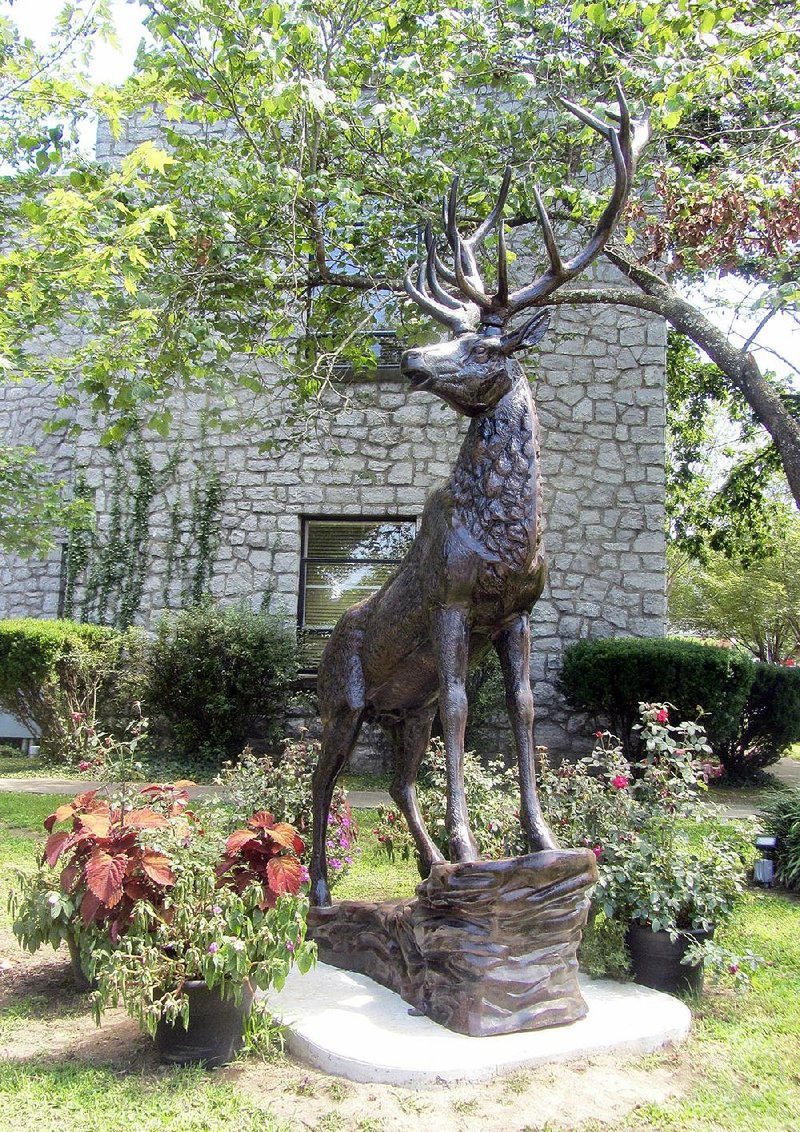JASPER -- You can call this elk "Newt." That's the name local officials have given to the antlered statue dedicated recently on the courthouse lawn in Jasper, marking Newton County's self-styled stature as "Elk Capital of Arkansas."
The Natural State's elk have been in the news over the last 16 months for an unhappy reason -- the detection of chronic wasting disease among the species in seven northern counties including Newton. The ailment, also found in Arkansas' deer population, causes brain deterioration and eventual death.
But it appears, according to staff members at visitor centers in and around Buffalo National River, that the area's elk herds are holding their own despite the menacing affliction. So visitors have a chance of spotting the handsome herbivores in roadside meadows, most likely in the hours soon after sunrise and just before sunset. Autumn is considered the best viewing season.
That encouraging situation was reflected in another event at last month's Buffalo River Elk Festival, following the unveiling of the Newt statue. It was the yearly drawing for elk hunt permits, reported in the Newton County Times. Some 29 winners, including a Jasper woman, will receive permits to hunt Arkansas elk on public land this fall.
The story also reported that applications are open through Saturday for the hunting of another 52 elk on private lands. Whatever a person's view of hunting, those numbers indicate that the Arkansas Game and Fish Commission believes the area's elk population continues to number around 500 despite the disease's presence.
Thanks to the elk and the nearby Buffalo River, perhaps the state's most precious natural wonder, Jasper, with a population just under 500, looks like a virtual boom town compared with the many dying or fading small communities across the state.
Most storefronts are filled around the square, which is occupied by the stone courthouse built during the Great Depression by the federal Works Progress Administration. There are several decent restaurant choices, most notably the venerable Ozark Cafe, in business since 1909. A sign on the square remembers the local high school's basketball team, state champions in its category in 1960.
On Arkansas 7 just north of Jasper, Hilary Jones Wildlife Museum and Elk Information Center, operated by the Game and Fish Commission, aims to excite visitors about the possibility of seeing elk: "That these magnificent monarchs of the deer family have come back to a place where we once crowded them out is a source of pride to us."
This refers to the fact that the Eastern elk subspecies native to Arkansas became extinct in the late 19th century due to forest clearing and overhunting. In the early 1980s, the commission released 112 Rocky Mountain elk on National Park Service land in Newton and Searcy counties. Today's 500 or so elk in the state's northern reaches are their descendants.
The Ponca Elk Education Center, 15 miles west of Jasper, occupies a handsome log building. Also a Game and Fish Commission site, it displays several adult elk and calves in mounted taxidermy displays. An information panel headlined "Born to be big" reports that elk weigh about 35 pounds at birth. A mature bull elk weighs 800 pounds or more and stands 5 feet tall at the shoulder.
Hands-on exhibits of hides, skulls and other artifacts allow visitors to literally get the feel of the local environment. There is also a geology display, as well as interactive computer quizzes and a birding window to view the feeders on the wraparound deck.
Displays at the federally operated Tyler Bend Visitor Center, 40 miles east of Jasper on the river near St. Joe, put the past and current presence of elk in context with human history along what is now Buffalo National River. A short film gives a glimpse of the natural setting that once again is making a congenial home for elk, despite the present health challenge.
Hilary Jones Wildlife Museum & Elk Information Center, on Arkansas 7 a half-mile north of Jasper's Little Buffalo bridge, is open 9 a.m.-5 p.m. daily. Admission is free. Visit arkansaselkcenter.com or call (870) 446-6180.
Ponca Elk Education Center, along Arkansas 43 in Ponca, is open 10 a.m.-4:30 p.m. Tuesday-Saturday. Admission is free. For details, call (870) 861-2432.
Buffalo National River's Tyler Bend Visitor Center, 2322 Tyler Bend Road, St. Joe, is open 8:30 a.m.-4:30 p.m. daily. Admission is free. Visit nps.gov/buff or call (870) 439-2502.
Weekend on 07/13/2017

